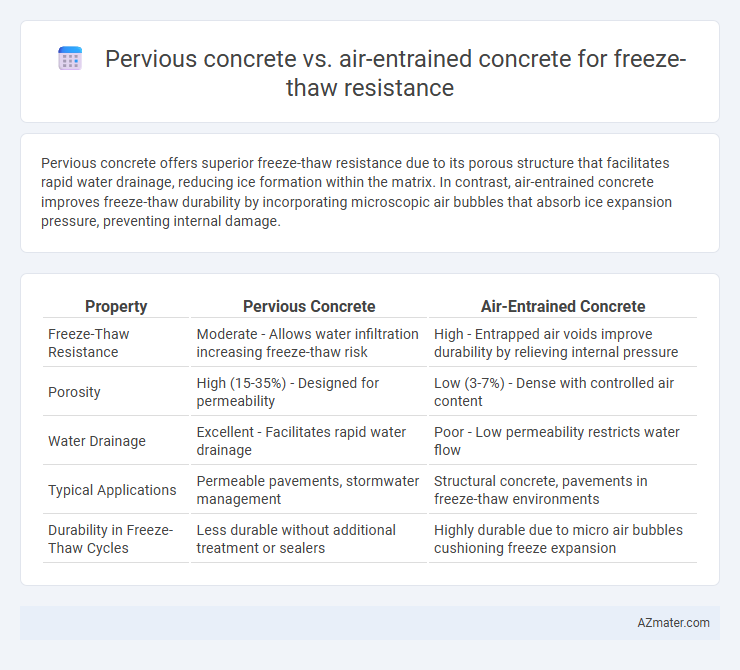Pervious concrete offers superior freeze-thaw resistance due to its porous structure that facilitates rapid water drainage, reducing ice formation within the matrix. In contrast, air-entrained concrete improves freeze-thaw durability by incorporating microscopic air bubbles that absorb ice expansion pressure, preventing internal damage.
Table of Comparison
| Property | Pervious Concrete | Air-Entrained Concrete |
|---|---|---|
| Freeze-Thaw Resistance | Moderate - Allows water infiltration increasing freeze-thaw risk | High - Entrapped air voids improve durability by relieving internal pressure |
| Porosity | High (15-35%) - Designed for permeability | Low (3-7%) - Dense with controlled air content |
| Water Drainage | Excellent - Facilitates rapid water drainage | Poor - Low permeability restricts water flow |
| Typical Applications | Permeable pavements, stormwater management | Structural concrete, pavements in freeze-thaw environments |
| Durability in Freeze-Thaw Cycles | Less durable without additional treatment or sealers | Highly durable due to micro air bubbles cushioning freeze expansion |
Introduction to Freeze-Thaw Resistance in Concrete
Freeze-thaw resistance in concrete refers to the material's ability to withstand cycles of freezing and thawing without significant deterioration, which is critical in cold climates. Pervious concrete, designed with interconnected voids, facilitates rapid drainage but may exhibit lower freeze-thaw durability due to increased water retention in pores. Air-entrained concrete incorporates microscopic air bubbles that provide space for water expansion upon freezing, significantly enhancing freeze-thaw resistance by reducing internal stress and preventing cracking.
Understanding Pervious Concrete: Composition and Properties
Pervious concrete is composed of coarse aggregates, cement, water, and minimal fine aggregates, creating a highly porous structure that allows water to drain through, reducing surface water accumulation and mitigating freeze-thaw damage. Its interconnected voids enhance permeability but may compromise freeze-thaw resistance compared to dense, air-entrained concrete, which incorporates microscopic air bubbles to provide internal stress relief by accommodating expanding ice. Understanding the composition and porosity of pervious concrete is essential for optimizing freeze-thaw durability in cold climates where water infiltration and freezing cycles are prevalent.
Air-Entrained Concrete: Key Features and Benefits
Air-entrained concrete contains microscopic air bubbles that enhance freeze-thaw resistance by allowing water to expand without damaging the structure. These entrained air voids reduce internal pressure and prevent cracking during freeze-thaw cycles, improving durability and longevity in cold climates. This technology is especially beneficial for pavements, bridges, and other infrastructure exposed to harsh weather conditions.
Mechanisms of Freeze-Thaw Damage in Concrete
Pervious concrete exhibits increased vulnerability to freeze-thaw damage due to its high porosity, which allows water to infiltrate and expand upon freezing, causing internal microcracking and surface scaling. Air-entrained concrete enhances freeze-thaw resistance by incorporating microscopic air bubbles that provide pressure relief points for expanding ice, thereby reducing internal stress and mitigating cracking. The key mechanism influencing freeze-thaw durability lies in the concrete's pore structure and its ability to accommodate ice expansion, with air-entrainment providing critical microvoids that pervious concrete lacks.
How Pervious Concrete Handles Freeze-Thaw Cycles
Pervious concrete enhances freeze-thaw resistance by allowing water to drain through its porous structure, reducing hydrostatic pressure buildup during freezing. Its interconnected voids minimize the risk of internal cracking compared to air-entrained concrete, which relies on microscopic air bubbles to absorb expansion. The permeability of pervious concrete thus improves durability in freeze-thaw environments by effectively managing water retention and ice formation within the matrix.
Performance of Air-Entrained Concrete Under Freeze-Thaw Conditions
Air-entrained concrete exhibits superior freeze-thaw resistance due to the intentional inclusion of microscopic air bubbles that provide space for water expansion during freezing, reducing internal stress and preventing cracking. These air voids improve durability by mitigating the damage caused by the cyclical freezing and thawing of water within the concrete matrix. In contrast, pervious concrete, while beneficial for drainage, generally lacks such air entrainment and often shows reduced performance under freeze-thaw cycles unless specifically modified.
Comparative Analysis: Pervious vs Air-Entrained Concrete Durability
Pervious concrete offers superior freeze-thaw resistance due to its high permeability, allowing water to drain quickly and reducing internal pressure during freezing cycles. Air-entrained concrete incorporates microscopic air bubbles that provide space for ice expansion, enhancing durability against freeze-thaw damage. Comparative analysis shows air-entrained concrete generally achieves higher long-term durability in freeze-thaw environments, while pervious concrete excels in managing surface water but may require additional air entrainment for improved freeze-thaw resilience.
Applications and Limitations in Cold Climates
Pervious concrete provides excellent drainage and reduces surface water buildup, making it advantageous for cold climates where freeze-thaw cycles are frequent, but it typically has lower freeze-thaw resistance due to its higher porosity and lower strength. Air-entrained concrete contains microscopic air bubbles that improve its durability under freeze-thaw conditions by accommodating ice expansion, making it ideal for structural applications in cold regions. However, air-entrained concrete may have reduced permeability compared to pervious concrete, limiting its use in applications requiring rapid drainage.
Maintenance and Longevity Considerations
Pervious concrete offers superior freeze-thaw resistance due to its high permeability, allowing water to drain quickly and reducing internal pressure that causes cracking. Air-entrained concrete contains microscopic air bubbles that provide space for water to expand during freezing, enhancing durability but requiring regular maintenance to prevent clogging and maintain its protective air void system. Proper upkeep of pervious concrete extends longevity by preventing sediment build-up, while air-entrained concrete demands consistent inspection to sustain its freeze-thaw resilience over time.
Conclusion: Choosing the Right Concrete for Freeze-Thaw Resistance
Pervious concrete offers excellent drainage properties but typically exhibits lower freeze-thaw resistance due to its high porosity and reduced material density. Air-entrained concrete improves freeze-thaw durability by incorporating microscopic air bubbles that relieve internal pressure from ice formation, making it more suitable for harsh climates. Selecting air-entrained concrete is generally recommended when prioritizing freeze-thaw resistance in structural and pavements exposed to repeated freeze-thaw cycles.

Infographic: Pervious concrete vs Air-entrained concrete for Freeze-thaw resistance
 azmater.com
azmater.com